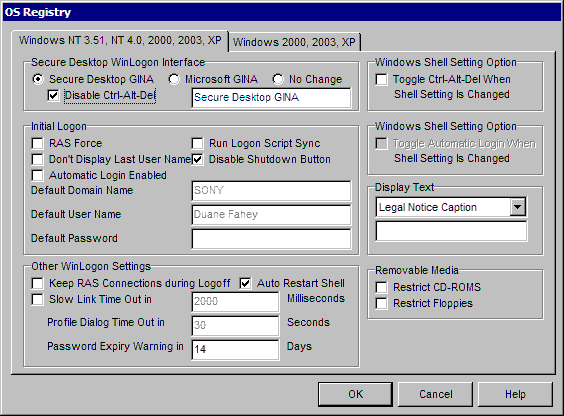




 |

What's a GINA WinLogon Interface? Microsoft documents a method of replacing the interface to the Windows NT4/2000/2003/XP WinLogon process. This is typically known as a GINA DLL. Microsoft's GINA DLL is named MSGINA.DLL. Visual Automation's is named SASGINA.DLL. This is the only method we know of for disabling the Ctrl-Alt-Del function in Windows NT4/2000/2003/XP. The registry simply chooses which DLL file to use. Visual Automation's DLL passes most of the calls on to the MSGINA.DLL, except for the Ctrl-Alt-Del functionality. Other companies have GINA DLLs included with their software. Only one GINA DLL can be used at a time. Other software packages that include GINA DLLs include Symantec's PC Anywhere, Intellution's FIX, and Novell Netware. If you wish to use someone else's GINA DLL, but you would still like to restrict the functionality found in the Windows Security dialog that is displayed when you depress Ctrl-Alt-Delete, take a look at OS Policy.
Symantec's pcAnywhere program has the ability of chaining to other GINA DLL files. Typically, the pcAnywhere GINA DLL (AWGINA.DLL) would chain to Microsoft's GINA DLL (MSGINA.DLL). Secure Desktop's GINA DLL (SASGINA.DLL) also chains to MSGINA.DLL as do most other replacement GINA DLLs. pcAnywhere has the ability to chain to other GINA DLLs via a registry setting. For more details, please visit Symantec's web site at http://www.symantec.com and search for knowledge base document id 199852785735 titled "What is a GINA?". So, a possible scenario would be to configure the AWGINA.DLL to chain to the SASGINA.DLL which would then chain to the MSGINA.DLL. In this scenario, you could use pcAnywhere for remote configuration and have the Ctrl-Alt-Delete disabled by Secure Desktop.
In Windows NT4/2000/2003/XP, the registry contains the information necessary to change all of the information in this dialog. If you need to modify these settings manually, you will need to run REGEDT32.EXE. USE CAUTION: This is a database containing very important information about how your Windows NT4/2000/2003/XP system operates, modifying the wrong parameter could lead to nasty results. Further details about these registry settings can be found in the Resource Kits for Windows NT 4, 2000, 2003, and XP.


 |